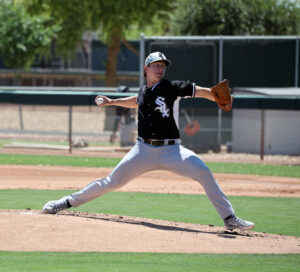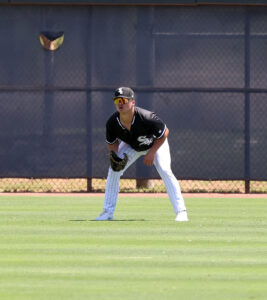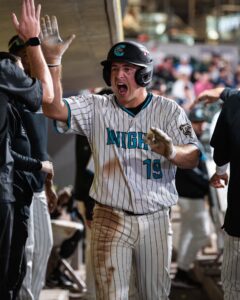Prospect Focus: Gavin Sheets
Looking down the tunnel from the dugout steps, it’s hard to miss the ballplayer sauntering out of the clubhouse. The light, staccato sound of cleats on concrete deceives. As he comes into the light, player number 24 immediately projects the image of a power-hitting first base prospect. That’s what he was drafted as and, built like a brick shithouse, he looks the part.

We’ve gotten quite a few questions recently from our readers about Gavin Sheets, the team’s 2nd round draft pick last June. I saw Gavin play a couple games in person in April, watched his BP sessions, interviewed him, talked with his hitting coach, and got a bunch of video. Fellow writer Clinton Cole has also seen him in other games in person during his first month of play this year. Combining all of that, let’s take a deeper look at Mr. Sheets, and the question that nearly all those readers are asking in some form: why is this power prospect not hitting home runs?
First, some background. The son of former major leaguer Larry Sheets, Gavin was initially drafted in the 37th round in 2014 as a prep, by the Orioles (his father’s former team). As expected he honored his commitment to Wake Forest, playing there for three seasons. As a junior, the younger Sheets hit a whopping 21 home runs in just 63 games, and was selected by the White Sox in the second round. He signed for an over-slot $2M bonus (slot was $1.392M), played a brief 4-game cameo in the AZL, then finished his draft year with 52 games at Kannapolis. Here in 2018, Sheets opens his first full pro season at Advanced-A Winston-Salem at age 22 (turned 22 in mid-April).
So where does Gavin stand today?
Speaking of deception, let’s start with numbers. Here are some of his stats to open 2018:
- .287/.410/.383 in 139 PA
- 0 HR, 1 3B, 9 2B (Iso of .096)
- 15.9% BB/PA
- 15.1% K/PA
That does not look like the numbers you’d expect of a player whose carrying tool is meant to be power. No long balls so far, despite playing home games in a band box. That number is causing concern among some of our readers. But look at the other numbers. How many power prospects have that high a contact rate? Next to none. How many walk at a 17% clip? Very few, though another is fellow White Sox prospect Zack Collins. And nine doubles in a month is nothing to scoff at, especially for a guy with below average speed – it puts him on a clip for over 40 on the season. Pretty much all his numbers run counter to expectations, though in more good ways than bad.
But where is the power?
Let’s eliminate some concerns right off the bat. First, those 65 or 70-grade marks for raw power are not phantasms or metal bat-catalyzed illusions. It’s in there, and that becomes obvious watching him in batting practice. He’ll launch serious bombs, some of the longest shots I saw in Winston-Salem (which says a lot given their current lineup). And in games, those line drives he hits – especially to the pull side – are rockets. The sound off the bat tells the story.
Is it his swing? Maybe it’s not built for loft in it’s current state? Let’s take a look at a BP session from the open side:
Looks like it’s got some bank on it to me. But here’s where it gets interesting. In this next video, we see Sheets work a long at-bat, and take two swings. Watch and see what jumps out at you:
Did you see that? The first hack, I’m fairly certain he was aiming for the parking lot behind the gift shop that sits beyond the right-center field concourse. But the second one? Linear, quick to the ball, and he turned it into a well-struck base hit.
Was that on-the-fly adaptation, or part of a broader mindset? Watching him play, that more controlled swing appeared much more often than the big, sweeping cuts. I asked Gavin what he was most focused on development-wise. Here was his answer:
You know, I don’t want to be the guy that strikes out. I hate striking out. So to have low strikeouts and high walk numbers is big for me. The goal for me is just putting the ball in play, having good at-bats.
He also added this:
Really big thing is my plate discipline, just trying to attack the fastball, and hitting pitches that are in my zone, trying not to make the zone any bigger than it is.
He didn’t talk about power – he talked about not striking out. Making good contact. Controlling the zone. It sure sounds like, at this point in his development, he’s laser-focused on swinging at the right pitches and putting barrel to ball. And his numbers echo that.
Adding fuel to the fire, here’s Winston-Salem Hitting Coach Charlie Poe talking about Sheets’ development as a hitter and what he’s focused on at this point:
His approach in the batter’s box, just keeping a smooth, under control swing, a good base, and not try to rush and get jumped out too far. Because he’s a big guy and he kinda wants to get out there and go get it, so we’re just trying to keep him under control in his swing and his base.
Combining those quotes with what we saw in that plate appearance tells me it’s pretty simple: It’s a choice. Controlled swing, plate discipline, and swinging at the right pitches.

Most any hitting coach will tell you that they’d rather see a minor league hitter contact their way into power than the other way around. In days recently passed, some of the system’s top power bats (i.e. Courtney Hawkins) had serious problems with swing and miss and were trying to retain power while improving pitch selection and contact. Here we have the opposite path, and that seems like the better alternative.
My advice to White Sox fans is, don’t worry too much about the lack of home runs at this point. If you want an analogy, there’s a big time slugger who spent some years with the White Sox who in some ways showed a similar power expression curve. Jim Thome was also a left-handed-hitting first baseman (though he moved there from third base). In his first two years after being drafted, Big Jim hit a combined 16 home runs in 122 games – similar numbers at similar ages to what Sheets was doing at Wake Forest. But then in his next two seasons, he hit just 10 bombs in 166 total games. It wasn’t until his 5th professional season, as he was approaching and reaching the majors, that the home run numbers jumped all the way to gaudy.
I am not saying that Gavin Sheets is Jim Thome, so please don’t go down that road. And the leveling similarity above doesn’t account for Thome’s younger age either. It is just to show that lefty hitters with big, country-strong builds and obvious plus raw power, perhaps sometimes need to work on contact first and power later. Sheets’ quote sure seems to hint that’s exactly what he is doing. It’s a strategy that can and has worked before. And by the way, Thome himself is a special advisor to the White Sox, working with some of the team’s hitters.
When will Sheets’ approach become more oriented for long ball power? Will it ever? I’d bet it will, if I had to take a stance. Just not today. Maybe next year. Will he find a way to make a swing work that is somewhere between the big cuts and the more contact-oriented ones? For now, don’t lose sight of the fact that in his first full professional campaign, playing about a year younger than the league average, Gavin Sheets is doing very well at everything else in the batter’s box. We can check in on game power later.
Want to know right away when we publish a new article? Type your email address in the box on the right-side bar (or at the bottom, if on a mobile device) and click the “create subscription” button. Our list is completely spam free, and you can opt out at any time






